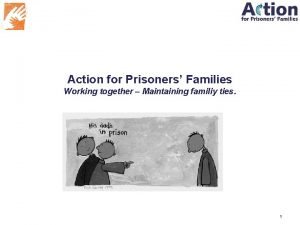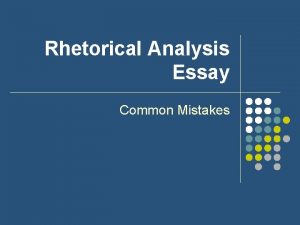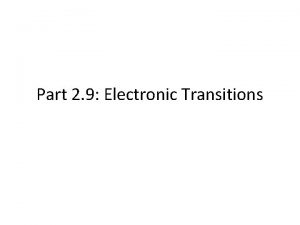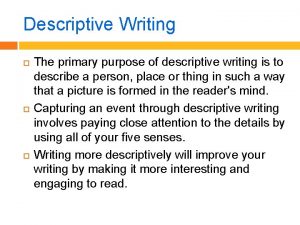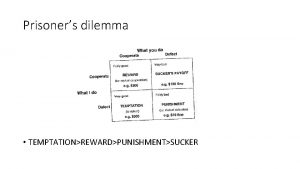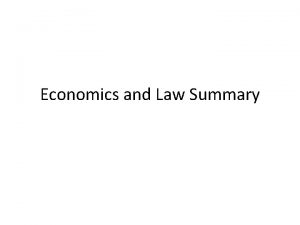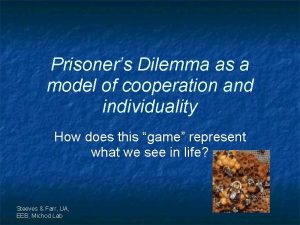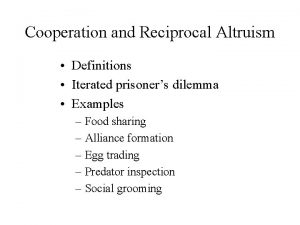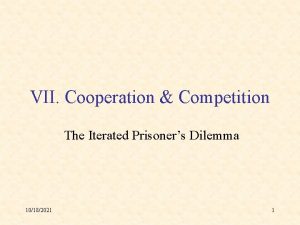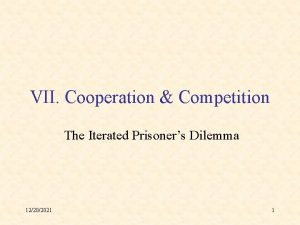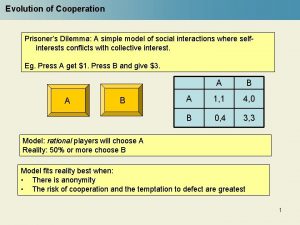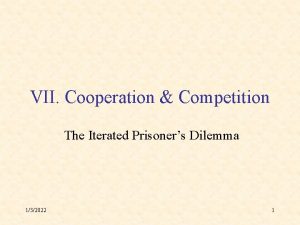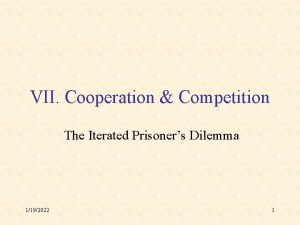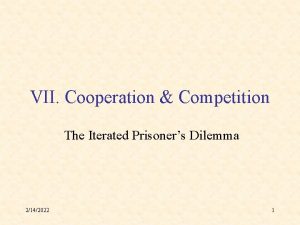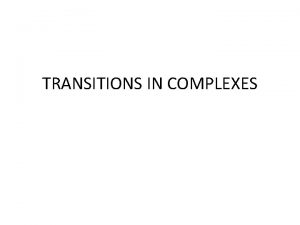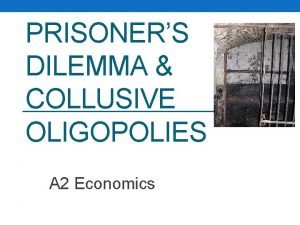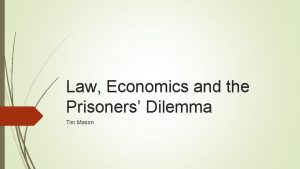Phase transitions to cooperation in the prisoners dilemma























![Cooperation Supporting Mechanics § group selection (competition between different populations) [1] § kin selection Cooperation Supporting Mechanics § group selection (competition between different populations) [1] § kin selection](https://slidetodoc.com/presentation_image/e5c099280c911803206a81e0158ed864/image-24.jpg)
![Cooperation Supporting Mechanics § costly punishment [2 c] § friendship networks [3] § time Cooperation Supporting Mechanics § costly punishment [2 c] § friendship networks [3] § time](https://slidetodoc.com/presentation_image/e5c099280c911803206a81e0158ed864/image-25.jpg)

- Slides: 26

Phase transitions to cooperation in the prisoner‘s dilemma Matthäus Kerres Matthäu Kerres | 18. 11. 2013 | 1

Introduction to Game Theory § Game theory problem: - 2 or more parties - both make a decision which effect themselves and other party Matthäus Kerres | 18. 11. 2013 | 2

Prisoner‘s Dilemma § Most profitable if everyone cooperates § Higher individual Layout non-cooperative players § Example: two parties: A, B Player A Player B Cooperate Defect Cooperate 50, 50 0, 80 Defect 80, 0 10, 10 Matthäus Kerres | 18. 11. 2013 | 3

Prisoner‘s Dilemma Player A Player B Cooperate Defect Cooperate 50, 50 0, 80 Defect 80, 0 10, 10 Matthäus Kerres | 18. 11. 2013 | 4

Replicator Equation relative behaviorj =“success” average success payoff (ifrequency = playersofdecision, expected others decision) § p(i, t) increases if: expected success > average success Matthäus Kerres | 18. 11. 2013 | 5

Stability of Games § now two strategies only: = p(1, t): decision one, here cooperate λ 1 = P 12 – P 22 λ 2 = P 21 – P 11 = p(2, t): decision two, here defect Matthäus Kerres | 18. 11. 2013 | 6

Four different Cases of Stability § Case 1: λ 1 = P 12 – P 22 < 0 and λ 2 = P 21 – P 11 > 0 P 22 > P 12 and P 21 > P 11 applies to prisoner dilemma, where: P 21 > P 11 > P 22 > P 12 remember: P 21 means, you choose decision 2 (defection) and the others chose 1 choosing 1 includes much more risk Matthäus Kerres | 18. 11. 2013 | 7

Four different Cases of Stability § Case 2: λ 1 = P 12 – P 22 > 0 and λ 2 = P 21 – P 11 < 0 P 22 < P 12 and P 21 < P 11 applies to harmony game, where: P 11 > P 21 > P 12 > P 22 Matthäus Kerres | 18. 11. 2013 | 8

Harmony Game Player A Player B Cooperate Defect Cooperate 4, 4 3, 2 Defect 2, 3 1, 1 § solution cooperation is stable ends up with cooperation by everybody Matthäus Kerres | 18. 11. 2013 | 9

Four different Cases of Stability § Case 3: λ 1 = P 12 – P 22 > 0 and λ 2 = P 21 – P 11 > 0 P 22 < P 12 and P 21 > P 11 applies to chicken game, where: P 21 > P 12 > P 22 Matthäus Kerres | 18. 11. 2013 | 10

Chicken Game Player A Player B Cooperate Defect Cooperate 3, 3 2, 4 Defect 4, 2 1, 1 § both solutions unstable cooperators coexist with defectors Matthäus Kerres | 18. 11. 2013 | 11

Four different Cases of Stability § Case 4: λ 1 = P 12 – P 22 < 0 and λ 2 = P 21 – P 11 < 0 P 22 > P 12 and P 21 < P 11 applies to stag hunt game, where: P 11 > P 22 > P 12 Matthäus Kerres | 18. 11. 2013 | 12

Stag Hunt Game Player A Player B Cooperate Defect Cooperate 3, 3 1, 2 Defect 2, 1 2, 2 § no nash equilibrium § both solutions stable full cooperation possible, depends on history Matthäus Kerres | 18. 11. 2013 | 13

Phase Transitions § Prisoners dilemma: vital interest to get to full cooperation § remember: Player A Player B Cooperate Defect Cooperate 50, 50 0, 80 Defect 80, 0 10, 10 Matthäus Kerres | 18. 11. 2013 | 14

Phase Transitions § Prisoners dilemma: vital interest to get to full cooperation § how to do that? Idea: transforming payoffs with taxes Player A Player B Cooperate Defect Cooperate 50, 50 0, 80 – 100 Defect 80 – 100, 0 10 – 100, 10 – 100 Matthäus Kerres | 18. 11. 2013 | 15

Phase Transitions § Prisoners dilemma: vital interest to get to full cooperation § how to do that? Idea: transforming payoffs with taxes Player A Player B Cooperate Defect Cooperate 50, 50 0, – 20 Defect – 20 , 0 – 90, – 90 Matthäus Kerres | 18. 11. 2013 | 16

Phase Transitions § Taxes: Tij = Pij 0 – Pij new Eigenvalues: λ’ 1 = λ 1 +T 22 – T 12 λ’ 2 = λ 2 +T 11 – T 21 original PD payoff new payoff § Taxes form different routes to cooperation § characterized by different kinds of phase transitions Matthäus Kerres | 18. 11. 2013 | 17

Phase Transitions § Route 1: Prisoner’s Dilemma Harmony Game transforms system from stable defection to stable cooperation Matthäus Kerres | 18. 11. 2013 | 18

Phase Transitions § Route 2: Prisoners Dilemma Stag Hunt Game Matthäus Kerres | 18. 11. 2013 | 19

Stag Hunt Game Player A Player B Cooperate Defect Cooperate 3, 3 1, 2 Defect 2, 1 2, 2 Matthäus Kerres | 18. 11. 2013 | 20

Phase Transitions § Route 2: Prisoners Dilemma Stag Hunt Game bistable system: leads history dependent to cooperation or defection to reach cooperation: reduce λ 2 largely negatively p 3(t) = λ 1 / (λ 1 + λ 2) Matthäus Kerres | 18. 11. 2013 | 21

Phase Transitions § Route 3: Prisoner’s Dilemma Chicken Game Player A Player B Cooperate Defect Cooperate 3, 3 2, 4 Defect 4, 2 1, 1 Matthäus Kerres | 18. 11. 2013 | 22

Phase Transitions § Route 3: Prisoner’s Dilemma Chicken Game transforms system from total defection (PD) to coexistence: p 3(t) = λ 1 / (λ 1 + λ 2) by increasing λ 1 we get higher cooperation Matthäus Kerres | 18. 11. 2013 | 23
![Cooperation Supporting Mechanics group selection competition between different populations 1 kin selection Cooperation Supporting Mechanics § group selection (competition between different populations) [1] § kin selection](https://slidetodoc.com/presentation_image/e5c099280c911803206a81e0158ed864/image-24.jpg)
Cooperation Supporting Mechanics § group selection (competition between different populations) [1] § kin selection (genetic relatedness) [1] § direct reciprocity [2 a] (repeated interaction) § indirect reciprocity [2 b] (trust and reputation) § network reciprocity [1] Matthäus Kerres | 18. 11. 2013 | 24
![Cooperation Supporting Mechanics costly punishment 2 c friendship networks 3 time Cooperation Supporting Mechanics § costly punishment [2 c] § friendship networks [3] § time](https://slidetodoc.com/presentation_image/e5c099280c911803206a81e0158ed864/image-25.jpg)
Cooperation Supporting Mechanics § costly punishment [2 c] § friendship networks [3] § time dependent taxation [6] Matthäus Kerres | 18. 11. 2013 | 25

Summary § what has to happen to create cooperation in the PD: § moving stable stationary solution away from pure defection § stabilizing unstable solutions § creating new stationary solutions Matthäus Kerres | 18. 11. 2013 | 26
 Prisoner's dilemma
Prisoner's dilemma Prisoners dilemma
Prisoners dilemma Prisoners dilemma
Prisoners dilemma Subir sachdev quantum phase transitions
Subir sachdev quantum phase transitions When prisoners come home
When prisoners come home After they arrived the prisoners are supposed to shower
After they arrived the prisoners are supposed to shower Action for prisoners families
Action for prisoners families Prisoners dillemma
Prisoners dillemma Adx florence cell
Adx florence cell What is mobile and stationary phase
What is mobile and stationary phase Csce 441
Csce 441 Normal phase vs reverse phase chromatography
Normal phase vs reverse phase chromatography Normal phase vs reverse phase chromatography
Normal phase vs reverse phase chromatography Tswett pronunciation
Tswett pronunciation Which detector used in hplc
Which detector used in hplc Line vs phase voltage
Line vs phase voltage Mobile phase and stationary phase
Mobile phase and stationary phase Phase to phase voltage
Phase to phase voltage Argumentative essay structure
Argumentative essay structure Transitions for rhetorical analysis
Transitions for rhetorical analysis Spectroscopy transitions
Spectroscopy transitions Elaboration transition words
Elaboration transition words Gregory is my beautiful gray persian cat
Gregory is my beautiful gray persian cat Vertical blinds
Vertical blinds Thesis statement topic
Thesis statement topic Transitions for conclusions
Transitions for conclusions Coherence transition words
Coherence transition words






